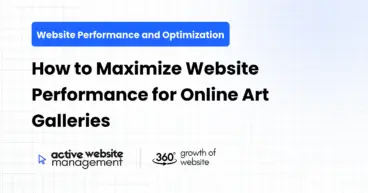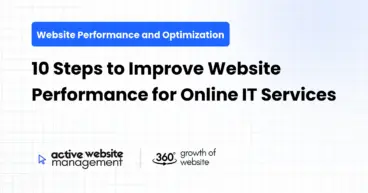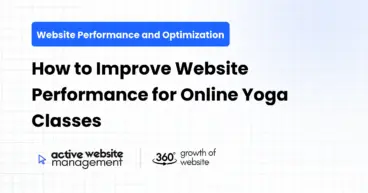December 17, 2024
8 min read
WordPress powers over 40% of all websites on the internet today, making it one of the most popular content management systems (CMS) worldwide. However, having a WordPress website isn’t enough. To stay competitive, it needs to load quickly. Website speed not only impacts user experience but also affects SEO rankings and conversion rates. In this article, we’ll explore how to optimize WordPress for lightning-fast performance and share best practices that will help ensure your website runs smoothly and efficiently.
Why Website Speed Matters?
The Impact on User Experience
Website visitors have little patience for slow-loading pages. Research by Google shows that 53% of mobile users leave a page if it takes more than 3 seconds to load. A slow website can frustrate users and drive them away, increasing your bounce rate and lowering engagement.
SEO Benefits
Page speed is a crucial ranking factor for search engines like Google. Websites that load faster are more likely to rank higher in search engine results pages (SERPs). Google’s algorithm prioritizes websites that offer the best user experience, which includes fast loading times.
Don’t Just Maintain Your Website—
Grow It using Active Website Management! Don't Wait for Growth—Accelerate It with Active Website Management
Conversion Rate Optimization (CRO)
A fast website not only attracts visitors but also helps convert them into paying customers. Studies have shown that even a one-second delay in page load time can reduce conversions by 7%. Therefore, optimizing your WordPress site for speed is directly linked to better sales and business growth.
Before diving into optimization strategies, it’s important to understand the various factors that can affect the performance of your WordPress website.
1. Hosting Provider
The foundation of your WordPress site’s speed lies in your web hosting provider. Shared hosting, while affordable, often leads to slower speeds due to server resource sharing. In contrast, a dedicated server or managed WordPress hosting can offer better performance.
2. Themes and Plugins
The choice of WordPress theme and plugins can impact website speed. Some themes come with unnecessary features that can slow down your site, while poorly coded plugins can lead to performance issues. Always choose lightweight, well-coded themes and regularly update plugins to ensure maximum performance.
Large image files can significantly slow down your website’s loading time. If images and videos are not optimized, they can take up valuable bandwidth and server resources. Properly optimizing your media files is crucial for ensuring fast performance.
4. External Scripts and Third-Party Services
External scripts, such as ads, social media embeds, and tracking codes, can slow down your website. The more third-party scripts you load, the more time it takes for your page to render.
5. Caching
Caching is a technique that stores a static version of your website to reduce load time. When a user visits your site, caching allows the browser to retrieve preloaded assets, reducing the need to regenerate every element from scratch.
Best Practices to Optimize WordPress for Speed
Now that we’ve covered the main factors affecting performance, let’s look at some actionable steps you can take to optimize WordPress for lightning-fast performance.
1. Choose the Right Hosting Provider
Choosing the right hosting provider is the first step toward optimizing your WordPress website’s performance. As mentioned earlier, shared hosting is not ideal for high-performance websites. Consider the following options:
- Managed WordPress Hosting: Managed WordPress hosting providers like Kinsta, WP Engine, and SiteGround are optimized for WordPress, providing better performance, security, and uptime.
- VPS Hosting: If you prefer more control, a Virtual Private Server (VPS) offers more dedicated resources at a higher cost than shared hosting.
- Dedicated Hosting: For websites with high traffic, dedicated hosting ensures your website has all the resources it needs to perform well without sharing them with other websites.
Don't Wait for Growth—Accelerate It with
Active Website Management Don't Wait for Growth—Accelerate It with Active Website Management
2. Use a Lightweight Theme
Not all WordPress themes are created equal. Some themes are bloated with features that aren’t necessary for your site, which can slow it down. When choosing a theme, look for one that’s optimized for speed. Popular lightweight themes like Astra, GeneratePress, and Hello Elementor are designed to be minimalistic and fast. These themes focus on performance without compromising functionality.
Tip: If you already have a theme that’s slow, consider switching to a more performance-focused option.
3. Install a Caching Plugin
Caching is one of the most effective ways to speed up your WordPress site. Caching plugins create static versions of your pages and serve them to users, reducing server load and speeding up load times. Some popular caching plugins for WordPress include:
- W3 Total Cache: A highly customizable plugin that allows you to cache pages, minify CSS and JavaScript, and enable browser caching.
- WP Rocket: A premium plugin that simplifies caching setup and provides features like lazy loading and database optimization.
- Autoptimize: Helps optimize your website’s CSS, JavaScript, and HTML by combining and minifying files.
4. Optimize Images
Large images can be a major culprit in slowing down your WordPress site. Optimizing images reduces file size without sacrificing quality. Here are some tips for image optimization:
- Use Image Compression Tools: Plugins like Smush and ShortPixel automatically compress your images to reduce their size.
- Choose the Right File Format: Use the WebP format for smaller file sizes and better compression.
- Use Lazy Loading: Lazy loading only loads images as they are needed when users scroll down the page, reducing initial load times.
5. Minify CSS, JavaScript, and HTML
Minifying your website’s CSS, JavaScript, and HTML files reduces their size, helping to speed up page load times. Several caching plugins, like WP Rocket and W3 Total Cache, offer built-in minification options.
How to Minify Your Files:
- WP Rocket: Automatically minifies and combines files.
- Autoptimize: Minifies CSS, HTML, and JavaScript files and can even optimize Google Fonts.
6. Optimize Your Database
As you continue to use WordPress, your database accumulates unnecessary data, like post revisions, spam comments, and unused tables. Cleaning up your database improves performance and reduces its size.
You can use plugins like WP-Optimize or Advanced Database Cleaner to remove unwanted data and optimize your WordPress database.
7. Implement Content Delivery Network (CDN)
A Content Delivery Network (CDN) is a network of servers distributed across different geographic locations. By using a CDN, your website’s static files (images, CSS, JavaScript) are served from the server closest to the user, improving load times.
Some popular CDN providers include:
- Cloudflare: Offers a free CDN plan and includes features like SSL and security enhancements.
- KeyCDN: A reliable and affordable CDN solution for WordPress websites.
- StackPath: A fast, reliable CDN with high-performance caching features.
8. Reduce HTTP Requests
Every element on your website (images, scripts, stylesheets) requires an HTTP request to load. Reducing the number of HTTP requests can significantly improve load times. Here’s how:
- Combine CSS and JavaScript Files: Combine multiple CSS and JavaScript files into one to reduce HTTP requests.
- Minimize External Requests: Limit the use of external resources, like fonts or third-party plugins, that can slow down your site.
9. Regularly Update WordPress, Themes, and Plugins
Keeping WordPress, your theme, and plugins updated is crucial for maintaining performance and security. New versions often include bug fixes, performance improvements, and compatibility updates. Outdated software can slow down your site and introduce vulnerabilities.
Finally, it’s important to regularly monitor your website’s performance to ensure it’s running at optimal speed. Tools like Google PageSpeed Insights, GTmetrix, and Pingdom can help identify bottlenecks and offer suggestions for improvement.
Related Article: For more information on improving WordPress speed, check out Optimizing WordPress Images and Speed.
Optimizing your WordPress website for speed is a continuous process. As your website grows, new features, updates, and content can slow it down if not properly maintained. This is where Active Website Management (AWM) can help. AWM provides proactive website management services that ensure your website’s performance remains optimal.
Why Choose Active Website Management?
- Proactive Speed Optimization: Regular audits and optimizations to keep your website fast.
- Continuous Updates: Ongoing content updates, security patches, and design improvements.
- Custom Performance Strategy: Tailored strategies to meet the unique needs of your business.
Conclusion
Optimizing WordPress for lightning-fast performance is essential for maintaining a high-performing, user-friendly website. By choosing the right hosting, optimizing images, minifying files, and using tools like caching and CDNs, you can dramatically improve your site’s speed. Regular maintenance and monitoring will ensure your website stays fast, competitive, and engaging for users.
For businesses looking to take performance to the next level, Active Website Management can help ensure your website grows continuously with regular optimizations, updates, and ongoing support.
By following these best practices, you’ll not only improve website performance but also enhance user experience, boost your SEO rankings, and increase conversions.






